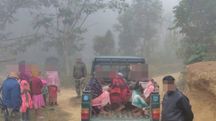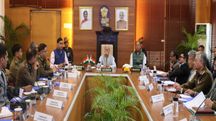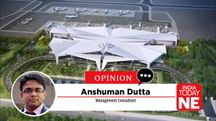Why can’t Dima Hasao stay calm?
Two years back, on April 24, 2019, in in Dima Hasao when an outfit introduced themselves as a group which is committed to ‘revamp the national struggle and fight for the liberation of a Sovereign, Independent Dimasa Nation’
 File image (source: Internet)
File image (source: Internet)GUWHATI: Two years back, on April 24, 2019, in in Dima Hasao when an outfit introduced themselves as a group which is committed to ‘revamp the national struggle and fight for the liberation of a Sovereign, Independent Dimasa Nation’, little did it drew attention. For, the rise of an insurgent group in Northeast is something not new and Dima Hasao has seen many of such outfits which want a separate ‘Dimaraji’ carved out of Assam and parts of Nagaland.
But the killing of five people in the hill district Thursday night has refreshed the decade long history of armed insurgency in the region.
Son of the Great River:
Located in the midst of Barail range, the two districts of Dima Hasao and Karbi-Anlong are two most potent tourist destinations of Assam. On Saturday, the Indian Railways launched two Vistadome railway coaches from Guwahati to New Halflong town two days after Dima Hasao National Army set seven trucks on fire and killed five men.
Equipped with the state of the art glass roof and glass windows, the coaches are supposed to provide a 360 degree view of the scenic beauty of Dima Hasao. It is first of its kind in Northeast. Even popular hill stations like Darjeeling is yet to get a vistadome service- such is the beauty of virgin land of Karbi Hills and Dima Hasao.
[caption id="attachment_101070" align="aligncenter" width="1080"] Vistadome coaches launched by Indian Raiways from Guwahati to New Haflong[/caption]
Vistadome coaches launched by Indian Raiways from Guwahati to New Haflong[/caption]
Amidst the scenic beauty of Dima Hasao and Karbi-Anglong, there lies the Dimasas, “Sons of the Great River’ (Brahmaputra). Dimasa is an indigenous, ethno- linguistic community living across the borders of Assam and Nagaland. It belongs to the Kirata – Indo-Mongoloid group which includes the Bodos and their allied tribes.
The 2011 Census puts the total population of Dimasa Kacharis in Assam at 1,02,961, and the total number of Kacharis in Nagaland at 13,034 — totaling 1,15,997 across both states.
The dream of Dimaraji- A separate state
Ringmai Dimasa, Information and Publicity secretary of Dimasa National Liberation Army after forming the organization had said, “The Dimasa tribe of India unitedly formed an armed revolutionary organisation in the name of Dimasa National Liberation Army under the chairmanship of Naisodao Dimasa and Home Secretary Kharmindao Dimasa. The organization is for and to develop a sense of brotherhood among the Dimasa and also to rebuild the trust and faith among the Dimasa society for regaining the Dimasa Kingdom,”
The proposed states of Dimaraji is comprised of the Dimasa-inhabited areas, namely Dima Hasao district, parts of Cachar district, parts of Nagaon district, Hojai district and Karbi Anglong district in Assam together with parts of Dimapur district in Nagaland.
Lawlessness in the Hills:
The demand for separate statehood for the Dimasas can be traced back to 1990s. The region has seen raging insurgency after the formation of the first insurgent group of the district - Dimasa National Security Force. Formed in 1991, the group was rather shot lived. All the members except its co-founder Jewel Garlosa surrendered en-masse in 1995.
Garlosa, then 26 years old, went on to form Dima Halim Daogah (DHD). According to the official website of Indian Army, “From 1994 to 1997 it enjoyed close relations with NSCN (IM) which helped it in all possible ways and also cornered large share of extortion amount collected by Dima Halim Daogah (DHD). The arrangement did not last long due to clash of interest over division of extortion amount and clash of interest over Dimaraji state proposed by it vis-à-vis Greater Nagaland proposed by NSCN(IM) which included Dimasa areas.
In 2003, a faction of DHD led by leader Dilip Nunisa entered into ceasefire with Government of India. But Jewel Garlosa stayed away to form a breakaway faction -the Black Widows.
The Black widow of Karbi Hills:
Floated with widows of 17 Dimasa men swore to avenge their husbands’ killing. The men were abducted from Cachar district and allegedly killed by militants of Hmar’s People’s Convention-Democrats- militant group, whose members hailed from the Chin-Kuki-Mizo ethnic cluster operated out of Assam, Mizoram and Manipur. Also known as DHD-J, the outfit unleashed terror across the hills. Killings, abduction, torching of villages, extortions –you name it!
Till 2009, Black Widows obstructed all developmental works in the hill areas. It involved the East West Corridor project of the National Highway Authority of India (NHAI) and a railway gauge conversion project.
Garlosa arrested in 2009 from Bengaluru by the National Investigation Agency (NIA) for diversion of development funds for terror activities between 2006 and 2009. According to NIA, funds were diverted with the help of elected members of NC Hills Autonomous Council. On 2 October, 2009, 382 cadres of DHD-J laid down their arms in front of the authorities at Haflong, headquarter of NC Hills district. In 2012, both factions of the Dima Halam Daogah signed a memorandum of settlement with the Central and Assam governments ending over two decades of active militancy in Dima Hasao.
No winner so far in fights between DNLA and security forces:
Talking to InsideNE, Rajeev Bhattacharya, a senior journalist from Guwahati who has been covering insurgency in Northeastern states for decades, said, “Only insurgent groups fizzle out from time to time in the twin hill districts of Assam but not insurgency because the conditions for the growth of armed movements continue to exist. The demand for separate states in these districts is not new. And so this time around, the new outfit has justified its existence by tagging itself with this demand.”
On May 22 this year, Assam police and Assam Rifles gunned down seven cadres of the Dimasa National Liberation Army (DNLA). The cadres were killed in Karbi Anglong district and a large cache of arms and ammunition was recovered from their possession.
[caption id="attachment_101077" align="aligncenter" width="530"] A truck set on fire by DNLA militants in Dima Hasao[/caption]
A truck set on fire by DNLA militants in Dima Hasao[/caption]
Assam Chief Minister Himanta Biswa Sarma, who took charge two weeks before the operation claimed that almost the entire DNLA group was eliminated.
“Almost the entire DNLA group has been eliminated. At least seven militants have been killed and two have been injured,” Sarma told the media.
However, the killing of five truck drivers and handymen in Dima Hasao district proved otherwise. Sources say the DNLA, like the previous militant outfits operating out of the region has resorted to extortion and kidnappings to generate money. Sources say, the killing of truck drivers is related to no-payment of extortion money by cement factories based out of the region.
A 2016 research paper by Brigadier Sushil Sharma for the Vivekananda International Foundation credits the NSCN (IM) for 'finding a novel way of generating revenue from smaller underground surrogates'. According to reports, the security officials have been probing a nexus between NSCN-IM and DNLA.
Copyright©2025 Living Media India Limited. For reprint rights: Syndications Today









